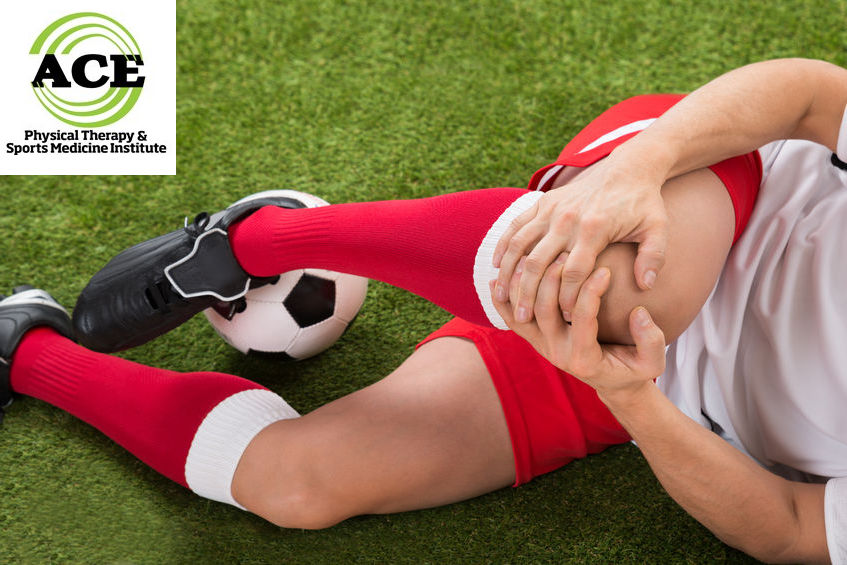GROWTH PLATE CONSIDERATIONS WITH AN ANTERIOR CRUCIATE LIGAMENT (ACL) TEAR

Tid Bits of Info
- ACL ruptures have increased more than 3x in skeletally immature athletes in the past 20 years.
- Intra-articular reconstruction in truly skeletally immature patients using a soft-tissue graft through a transphyseal tibial tunnel has proven to be successful.
- Girls rupture their ACL more frequently than boys.
- Non-surgical treatment of an unstable knee has not been very successful.
- Seek the advice and treatment from a Physical Therapist if your child ruptures their ACL.
As more young people participate in organized sports, the rate of injuries has increased. While proper training in various techniques can help reduce injuries, some youth still suffer from injuries like a torn Anterior Cruciate Ligament (ACL). Knee injuries can cause long-term problems for young athletes especially if left untreated. Up until recently, treatment of ACL injuries in youth has been risky because their bones are still growing. Now the outlook is more positive. Newer reconstructive techniques for youth are proving safe and effective for skeletally immature knees.
Bone Development and ACL Injuries
As children develop, their bones grow in length and diameter. The growth occurs from the growth plate (epiphyseal growth plate) that is located near the end of the long bones. The long bones of the body have at least two growth plates located near the end of the bones. All long bones have an area called the epiphysis, which is the rounded end of the bone. The long, middle part (or shaft) of the bone is the diaphysis; the area where the bone gets wider at its end is the metaphysis.Growth plates sit between the metaphysis and the epiphysis.
When the skeleton is mature, the growth plate “closes,” and the long bone is considered fully developed. A torn ACL on a skeletally immature athlete causes knee instability. If injured athletes do not want to completely stop playing their sport and become sedentary for the rest of their lives, they need to treat the injury and stabilize the knee. Otherwise, their knee is pre-disposed to arthritic changes later in their life.
ACL Treatment and Young Athletes
What is the safe way to stabilize the knee in a young athlete? Many surgeons have shied away from performing ACL reconstruction surgery on young patients because the primary procedure involves drilling a “tunnel” through the growth plate of the tibia. There have been reports of stunted growth, angled growth, over-growth and leg length discrepancies following ACL reconstruction in the skeletally immature athlete.

Newer techniques of graft placement (entirely epiphysis) are being attempted to avoid disrupting the growth plate. Follow up studies of these techniques indicate that the risk is low for growth plate damage and the post-operative symptoms are much less severe than the techniques that take the tunnel through the epiphysis.
The most recent data indicates that soft tissue grafts (primarily a hamstring graft) are able to be placed through the epiphysis without causing it to “close” prematurely. The increased use of “soft tissue” grafts has made surgeries that stabilize the knee of a skeletally immature athlete much more common. Proper rehabilitation following these surgeries is critical if the young athlete wants to return to their sport.
Physical Therapy and ACL Recovery
Seek the advice and treatment of a Physical Therapist that specializes in orthopaedic rehabilitation. These licensed professionals are capable of developing a treatment plan that will rehabilitate the young athlete from the time of the surgery to their return to the sport that they love. These protocols will include a range of motion exercises to restore normal joint motion and strengthening exercises that include the core and lower extremities.
Seeking treatment from a Physical Therapist is easy and does not require a doctor’s prescription. In the case of a post-operative patient, they will have a prescription and any protocols that the doctor will require the patient to follow to avoid damaging the surgical procedure.
The incidence of ACL tears in skeletally immature athletes has more than tripled since the 1990’s. Until recently the young athlete had to wait for skeletal maturity to occur prior to having the surgery that reconstructed the ruptured ACL. Today’s techniques and graft choices have been proven to be safe to use in the skeletally immature knee. The growth plate is spared and the knee can be stabilized which enables the young athlete to return to their sport and prevent degenerative changes in their involved knee.

























I would love to learn more about this topic. Is it possible to get the references for the information regarding the type of surgical procedures and the follow-up results after physical therapy rehabilitation? It is great to be able to provide the younger patient with an option that could limit future detriment to their joints from wear-and-tear due to instability.